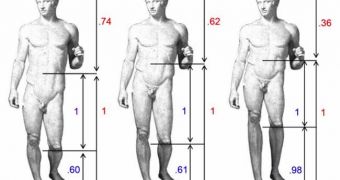Is beauty something we learn or are we born with the sense of aesthetics? A new research published in the journal PLoS ONE suggests that at least partly our sense of beauty is instinctive.
The Italian team presented original and distorted pictures of Classical and Renaissance sculptures to 14 subjects with no experience in art theory.
The proportions of the statues themselves matched "the golden ratio," a mathematical number discovered by the ancient Greeks and Renaissance artists believed it encoded the ideal beauty. Many organisms make use of it: it can be admired in the way nautilus shells curve or in the spiral of strawberries or sunflower seeds, or on a pineapple arrangement of the fruit parts. It can be seen in hurricanes, galaxies and a falcon flight pattern.
The golden ratio is about 1.618 and it is the only number whose value is its integer part divided to its fractional part: 1: 0.618. The golden ratio is encountered in many art symbols: in the Parthenon in Athens, the Great Pyramid of Giza and the Mona Lisa.
In the case of the study's subjects, the original images, matching the golden number, increased much more brain activity than the distorted images, including the insula, a brain nucleus linked to emotions.
"We were very surprised that very small modifications to images of the sculptures led to very strong modifications in brain activity," co-author Giacomo Rizzolatti, a neuroscientist at the University of Parma, told LiveScience.
Subjects also had to assess the beauty level of each image. Images perceived as beautiful activated the right amygdala, a brain nucleus linked to emotional memories. Most often, the original images were perceived as more beautiful than the distorted ones.
At the moment, it seems that the sense of beauty has an innate part in the insula and one related to subject's experiences in the amygdala. Still, researchers want to see if this is something general in human populations.
"We only know that Classical and Renaissance art is generally considered beautiful in Western culture. It would be interesting to propose a similar study across cultures to see whether these principles are universal or culture-bound." said researcher Cinzia Di Dio, a neuroscientist at the University of Parma.
"Future work can also investigate how the brains of art experts respond," wrote the authors.

 14 DAY TRIAL //
14 DAY TRIAL //